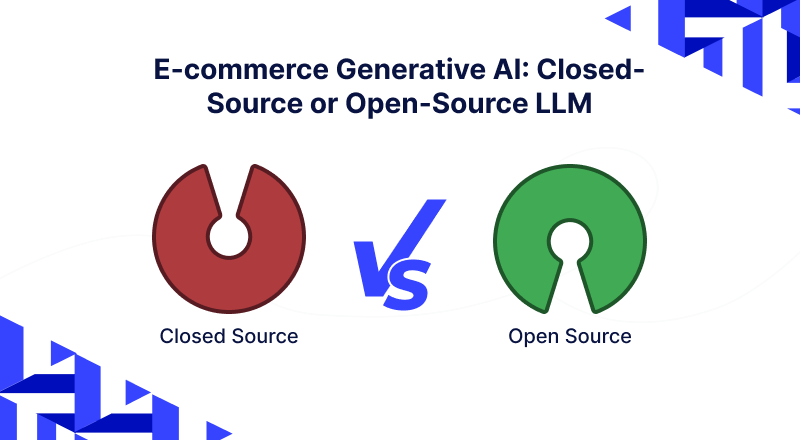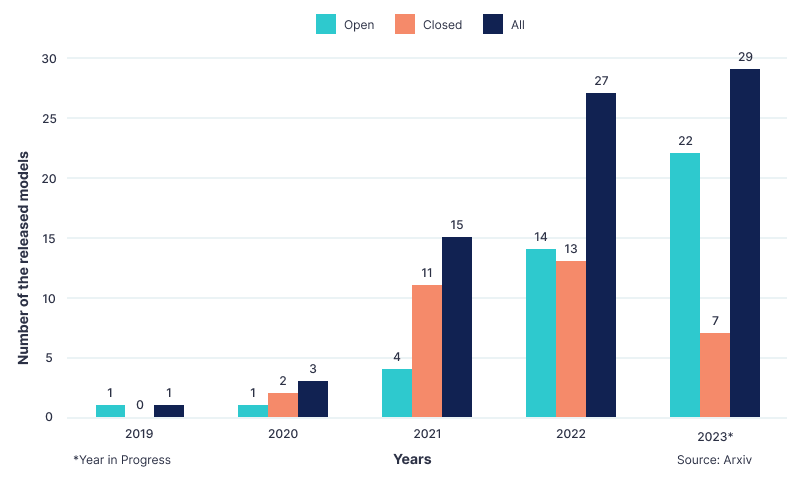In the fast-evolving landscape of enterprise technology, the question of whether to embrace Closed-Source OR Open-Source LLM solutions is a crucial one.
This debate is particularly pertinent when it comes to Large Language Models (LLMs). The innovative engines powering natural language understanding and generation.


With Generative AI at its core, it is enabling machines to generate human-like text and responses based on learned patterns and data.
Generative AI transforms e-commerce with open-source creativity and collaborative innovation. Closed-source precision ensures security and seamless integration.
Striking a balance between innovation and security is crucial for businesses leveraging Generative AI within both open-source and closed-source LLMs.
In this blog, we will delve into the nuances of closed-source and open-source LLMs, aiming to provide clarity on which path enterprises should tread.
According to Arxiv, in the past 1.5 years, there has been a greater number of new open-source models unveiled compared to closed-source models.


Security and Confidentiality
Closed-source LLMs, often developed and maintained by private companies, boast a proprietary advantage in terms of security.
The closed nature of the code ensures that sensitive information and proprietary algorithms are safeguarded from poking eyes.


Turnkey Solutions
For enterprises seeking a plug-and-play solution without the hassle of customisation, closed-source LLMs offer turnkey solutions.
These models are meticulously crafted to suit a wide array of applications, reducing the time and resources require for integration.
Streamlined Support and Updates
With closed-source LLMs, users benefit from streamlined support and updates directly from the provider.
This ensures a seamless experience, as patches, enhancements, and troubleshooting are handled by the experts behind the curtain.
Closed-Source LLMs:
- GPT-3.
- GPT-4.
- Megatron Turing NLG.
- Jurassic-1.
- HyperCLOVA
- Chinchilla.
- LaMDA.
Community Collaboration
Open-source LLMs succeed in the power of community collaboration. A diverse community of developers and researchers contributes to continuous improvement, making these models dynamic and adaptable to a variety of use cases.


Customization and Flexibility
Enterprises with specific needs may find comfort in the flexibility offered by open-source LLMs.
The ability to customize the codebase allows for tailoring the model to unique requirements, offering a level of control that closed-source alternatives might struggle to match.
Cost-Efficiency
One of the primary attractions of open-source LLMs is the potential for cost savings.
Enterprises can leverage the model without incurring hefty licensing fees, making it an appealing choice for organizations mindful of their budget constraints.
Open-Source LLMs
- Vicuna.
- LLaMA 2.
- OPT-175B.
- BLOOM.
- CodeGen.
As the closed-source vs open-source debate unfolds, it becomes clear that the choice depends on the unique needs and priorities of each enterprise.
For Those Prioritizing Security and Out-of-the-Box Solutions
Closed-source LLMs emerge as the frontrunners. The assurance of proprietary security measures and pre-packaged solutions aligns with the preferences of enterprises seeking stability and reliability.
For Those Embracing Customization and Collaborative Innovation
Open-source LLMs stand as champions. The adaptability and community-driven evolution offer a pathway for enterprises keen on harnessing the latest advancements and tailoring their language models to specific business objectives.
The choice between closed-source and open-source LLMs exists in a one-size-fits-all scenario.
Enterprises must carefully weigh their priorities, considering security, customization needs, and budget constraints.
Striking a balance between the advantages of both approaches may be the key to unlocking the full potential of Large Language Models in the dynamic realm of enterprise technology.
. . .





